Grizzly Bear Root Grubbing: Foraging Sign, Favored Plants, Site Selection
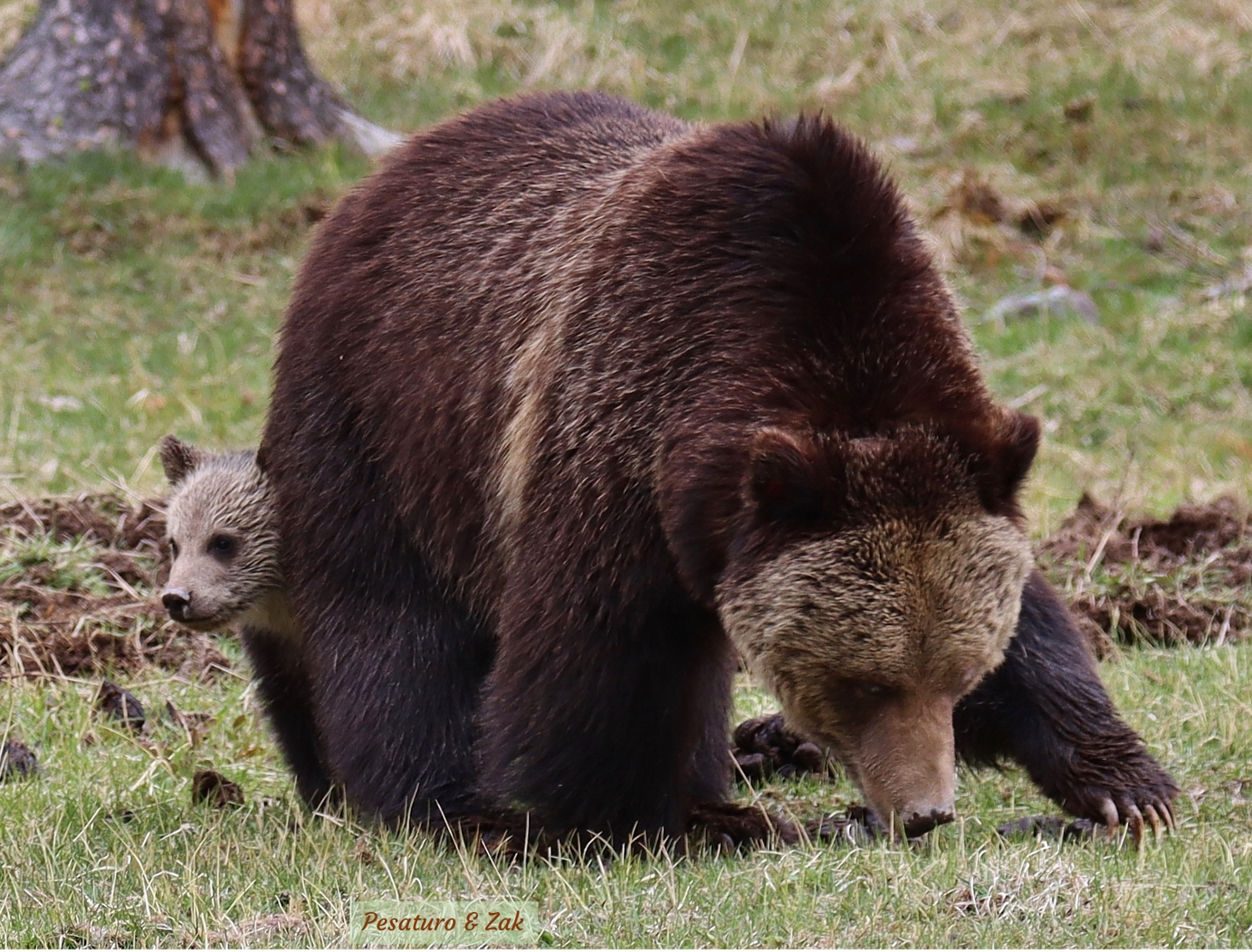
With longer, straighter claws and a larger shoulder hump, grizzly bears (Ursus arctos horribilis) are better diggers than black bears, and much more likely to dig for food. So it’s no surprise that roots comprise a greater portion of the grizzly’s diet. Recently I had the opportunity to observe grizzlies digging for roots in person. So of course I then set off to find this type of foraging sign elsewhere so I could target it with a trail camera. In this post I describe the foraging sign, preferred roots, where and when they dig them, how we chose our camera trap spots, and tips for choosing yours. Hopefully I will have for a follow-up post featuring video footage of grizzly bear root grubbing.
Grizzly Bear Root Grubbing in Yellowstone National Park
Last May, Bob and I attended a bear ecology program led by Jim Halfpenny and Nathan Varley, and organized by Original Wisdom. We got to see several different grizzlies foraging but sometimes we were too far away to really see what they were doing. In one case we were able to safely get a closer look because a river separated the bear from her human observers.
So from across the river we watched her flip bison pies to harvest earthworms, and dig up plants to harvest roots. We could not see what kind of plants she was digging up, nor the details of the foraging sign she left behind. We did get some nice photos with a zoom lens, however, and her two adaptations for efficient digging are evident in them. Long, straight claws and a large shoulder hump make Ursos arctos an efficient digger when grubbing for nutritious roots, foraging for burrowing rodents, and excavating winter dens.
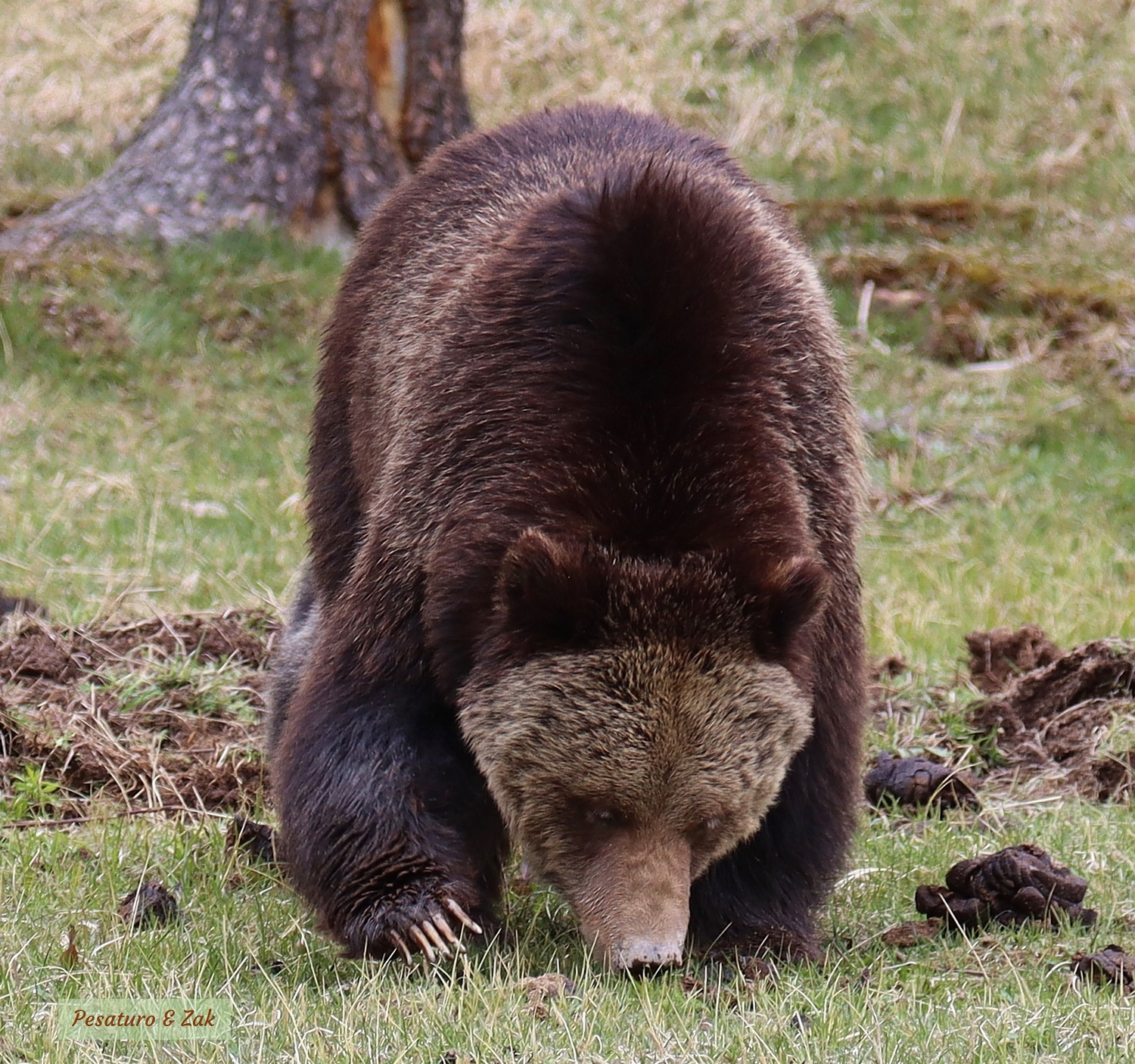
Finding Grizzly Foraging Sign
Next I wanted to find this root grubbing sign in a remote area where the wild animals, unlike those in national parks, shy from people. Many animals in Yellowstone are so used to people that they tolerate throngs of observers. It provides a wonderful opportunity to see animals and study their behavior, but it is no challenge to the tracker. It’s much more challenging where animals avoid people. So in early July we visited an area of Montana, outside national parks, where grizzlies are known to roam, and with meadows where bears might dig up roots. It wasn’t long before we found grizzly sign, but it did take some time to ascertain what it was.
Paws or Hooves?
We found several areas where something had been either digging with paws or churning with hooves, as cattle might do. And there were, in fact, cow pies scattered throughout. So, I thought, all of the soil disturbance we were seeing could have been caused by cattle. But some of the cow pies had been turned over or broken up, as a bear might do when searching for earthworms. And, there were a few marks in the soil that resembled a bear’s interdigital pad, but all of this sign was weathered and nothing was clearly diagnostic.

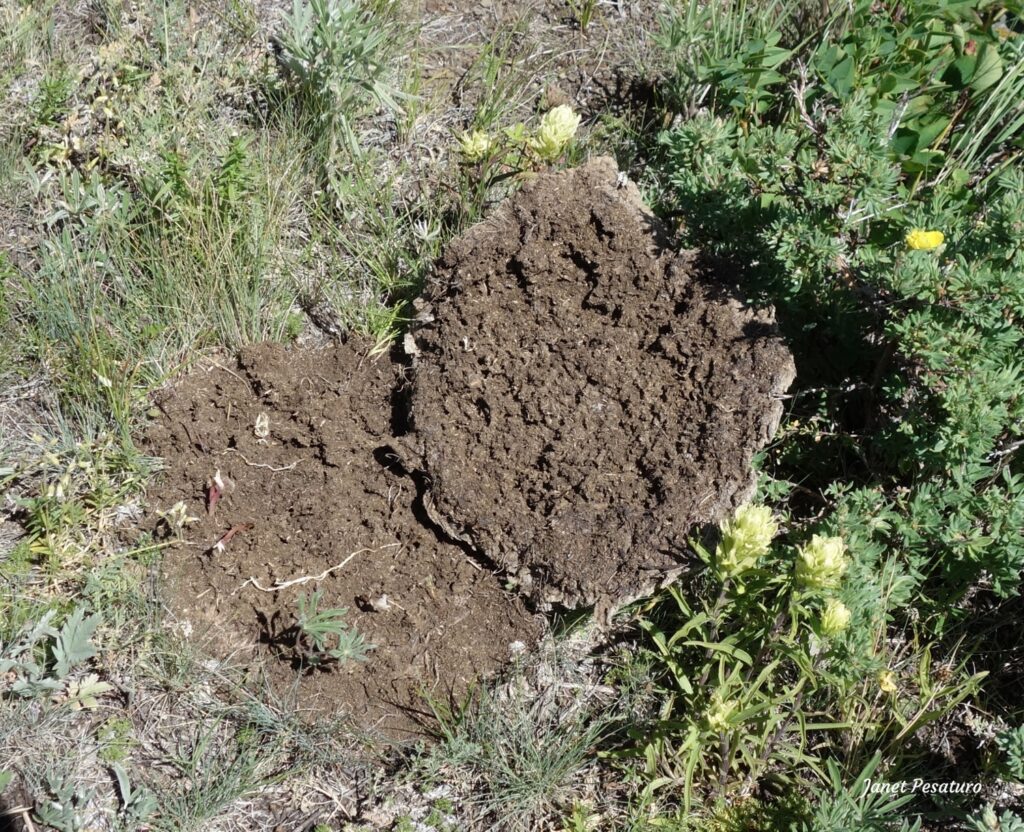
Clear Grizzly Sign
Eventually we found an area with much fresher sign, perhaps freshly worked the night before by a hungry ursid. Behold! Grizzly tracks and digs with obvious claw marks popped out! Success!
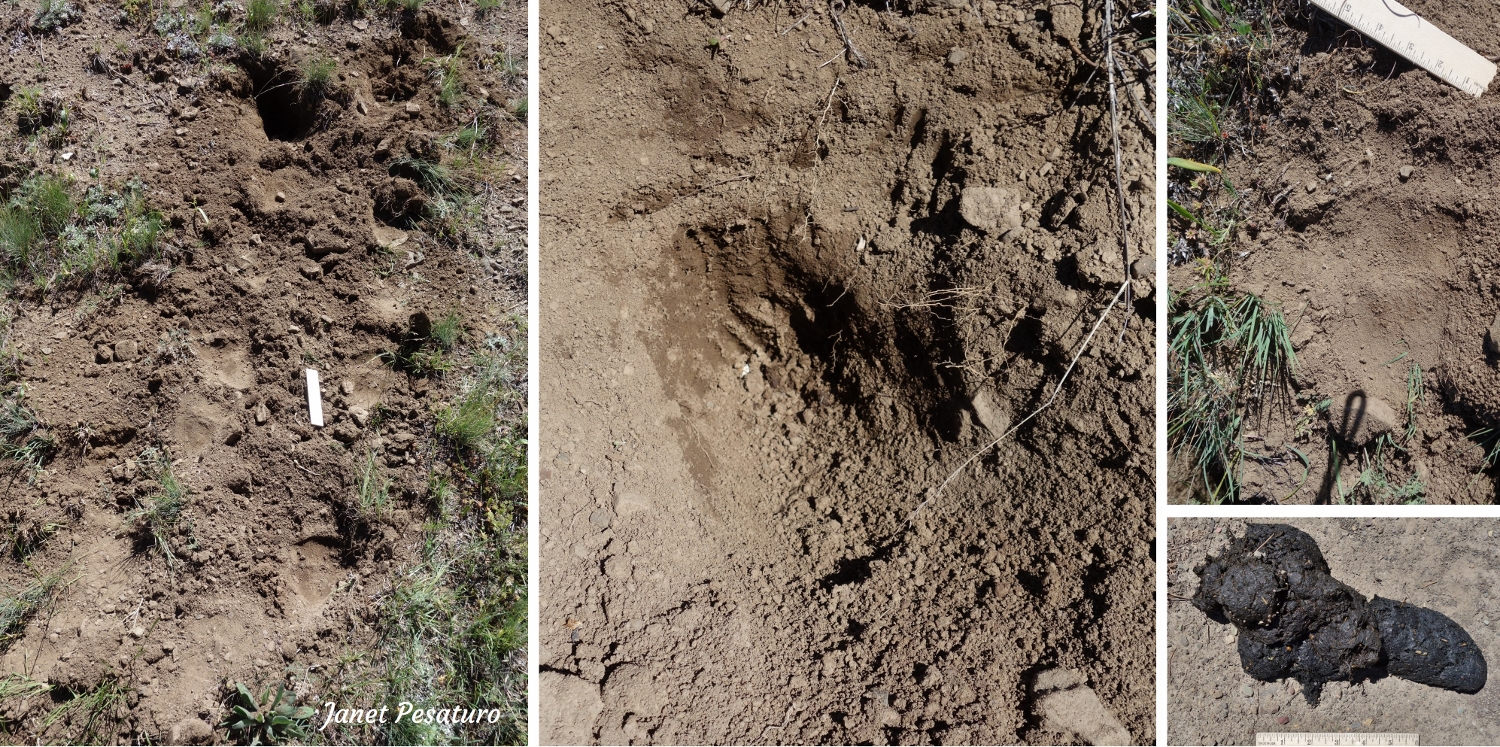
Plants at the Foraged Sites
I studied the plants where the bears had been digging and identified what I could by searching the web and sending photos to planty friends in western states. What I did not know was whether the plants remaining after a grizzly had worked an area represented the desired species or the rejects. But within the foraged areas I did find some species that grizzlies are known to favor, sometimes in abundance, so I think it’s likely that those were the plant species they were after. A few known to rank high on the menu were well represented at the foraged areas: at least one species of biscuitroot and one sweetvetch.
Biscuitroot
Several species of Lomatium are used by grizzlies. They are in the carrot family and their common name, biscuitroot, refers to their startchy, edible roots. The plant in a photo below was abundant in some foraged spots, and I think it is Lomatium triternatum, commonly called noneleaf biscuitroot or nineleaf desert parsley.
Sweetvetch
Hedysarum sulphurescens (yellow sweetvetch) was also present at the foraged areas. This and other Hedysarum species are known food sources for grizzlies. They are in the pea family, but grizzlies don’t wait for the pods; they dig up the fleshy roots.
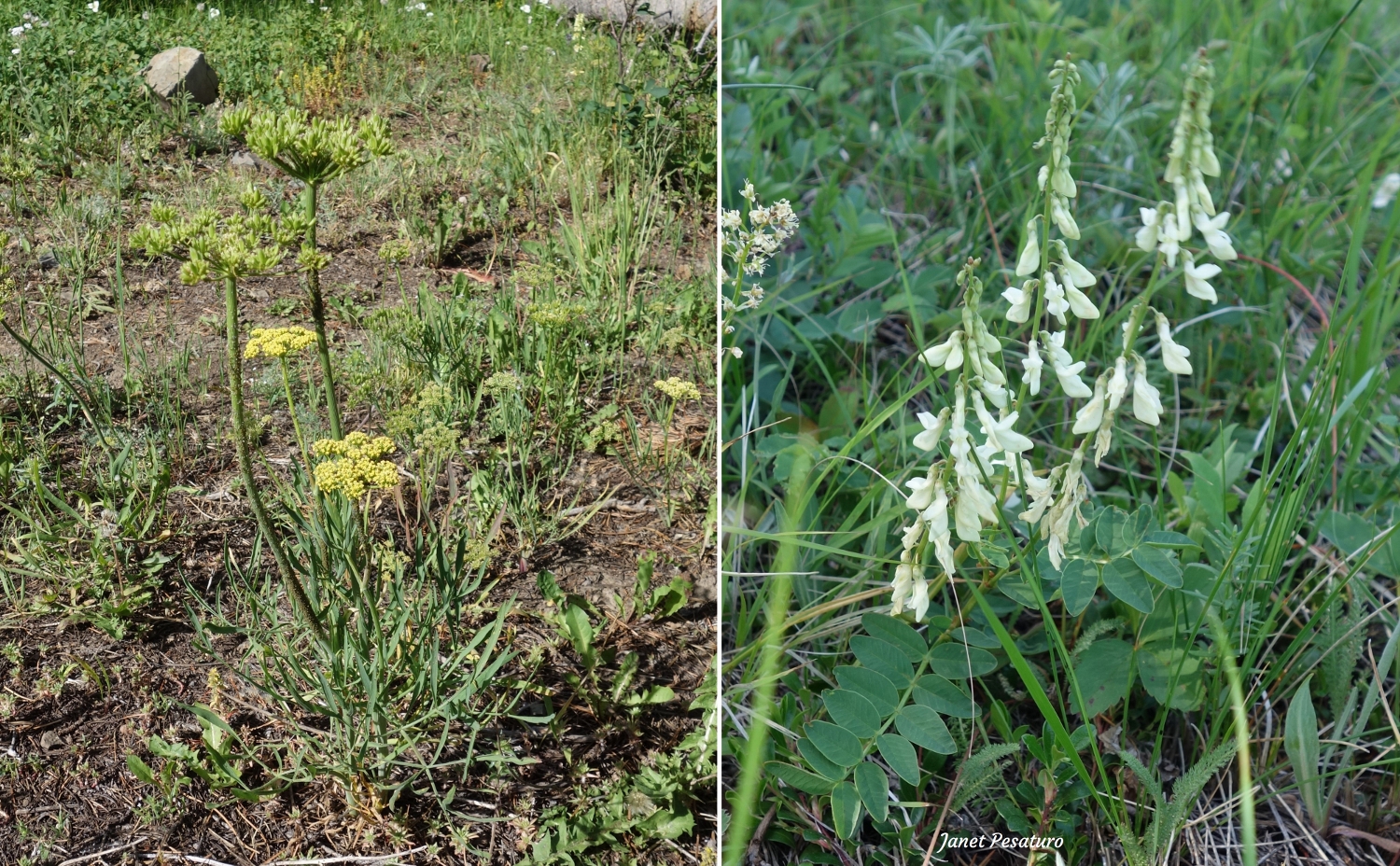
Wild Onions
Another plant at these sites caught our eyes because its roots, small onion-like bulbs, were sometimes lying on the ground near grizzly digs. Once again, I don’t know for sure if these bulbs were among the coveted or discarded species. We found Allium textile growing there and dug up one to confirm that the bulbs lying on the ground were from that plant. For humans A. textile is said to be edible but I haven’t found documentation of grizzlies consuming this or any other Allium, except for A. ursinum, which is consumed by brown bears in Croatia. I suspect grizzlies in Montana were eating the A. textile bulbs and just happened to drop a few.
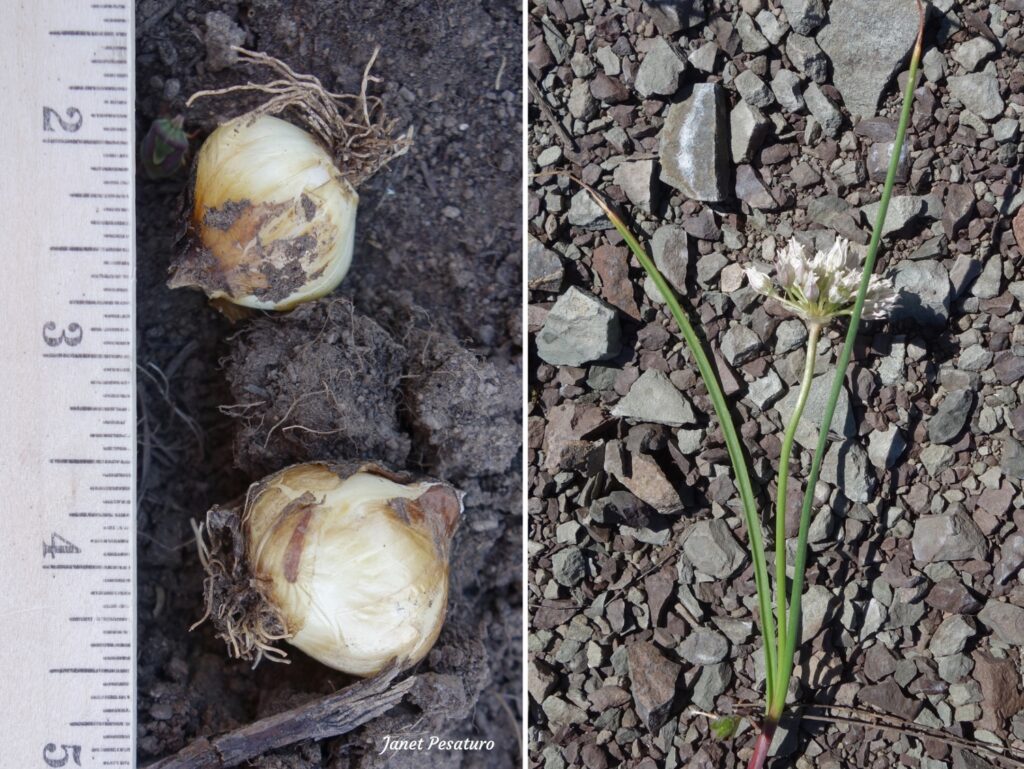
Pea Soup?
Pea soup is my mnemonic for remembering what grizzlies appeared to be eating at these digging sites in northwestern Montana – the roots of plants related to carrots, peas, and onions. Not being a plant taxonomist, I find that I need little tricks like that to have any hope of retaining the facts.
Other Roots on the Menu
These bears consume the roots of many plants but of course not all of them grow in all parts of the animal’s range, and most are eaten only during a certain narrow period of the year, when the root starch content is at peak. Here are some additional examples from the Yellowstone Ecosystem:
- Spring beauty (Claytonia spp., in the purslane family) is eaten mainly in June and July.
- Yampah (Perideridia spp., in the carrot family) is consumed primarily in July or August, just after it flowers.
- Sweet cicely (Myrrhis odorata, in the carrot family) is consumed mostly in late August and September.
How Grizzlies Decide Where and When to Forage
Presence of desired plant species is necessary but not sufficient to attract hungry bears. Other factors are root size, root starch content, and diggability of the soil. Evidently, the abundance of the plant is less important. The upshot is that to maximize nutritional gain and minimize the cost of foraging, grizzlies seek big, starchy roots where the digging is easiest.
Keep in mind that these are just guidelines, not rules carved in stone, for studies of grizzly foraging site selection have not been entirely consistent. Also, the extent to which one food source is used in a given year may vary according to the availability of other food sources that year. But the guidelines can be useful if, for example, you are looking for a good camera spot to capture grizzly foraging behavior.
Choosing a Camera Spot to Capture Grizzly Bear Root Grubbing
Here is a summary of tips for choosing a camera trap spot to capture a this behavior:
- Look for plants grizzlies are known to prefer, find out which months of the year they are likely to consume them, and plan your camera trapping accordingly.
- Grizzlies select for large roots so a site with large, robust specimens is better than a spot with scrawny ones.
- Grizzlies prefer to forage where soil is easy to dig, so a site with loose soil is better than one with hard, compacted soil. However diggability varies with moisture content and soil that seems hard and compacted might soften sufficiently after rain.
- And of course, look for grizzly foraging sign, for if it is there, it means the site was attractive enough to at least one bear, regardless of your judgement.
- If you do find grizzly bear root grubbing sign, look for remains of plants without roots near the digs. If you can identify them, you will know what kind of roots the bear was eating. However, bears may eat some species in their entirety – roots, greens, flowers, and all.
- Don’t forget your bear spray!
On July 12th we placed two trail cameras, each targeting a meadow with fresh grizzly foraging sign. There was a lot of robust looking biscuitroot and small amounts of sweetvetch, wild onions, and other plants that I didn’t identify. Since grizzlies are known to eat biscuitroots from July through fall, we will leave the camera in place at least through October. The rest is luck.
Have you observed grizzlies grubbing for roots? Feel free to share your observations, knowledge, and questions in a comment below!
Sources
Holcroft, A.C. and S.Herrero. “Grizzly Bear Digging Sites for Hedysarum sulphurescens Roots in Southwestern Alberta.” Canadian Journal of Zoology. 62 (1984): 2571-2575.
Mattson, D. “Root Grubbing.” From his informative website, AllGrizzly.
Mattson, D. J. “Selection of Microsites by Grizzly Bears to Excavate Biscuitroots.” Journal of Mammalogy. 78 (1997): 228-238.
Pengelly, I. and D. Hamer. “Grizzly Bear Use of Pink Hedysarum Roots Following Shrubland Fire in Banff National Park, Alberta.” Ursus. 17 (2006): 124-131.
For general camera trap placement tips, see:
Targeting Unique Habitat Features
Choosing a Good “Bridge” for a Trail Camera
Trail Camera Placement at Stream Mouth Crossings
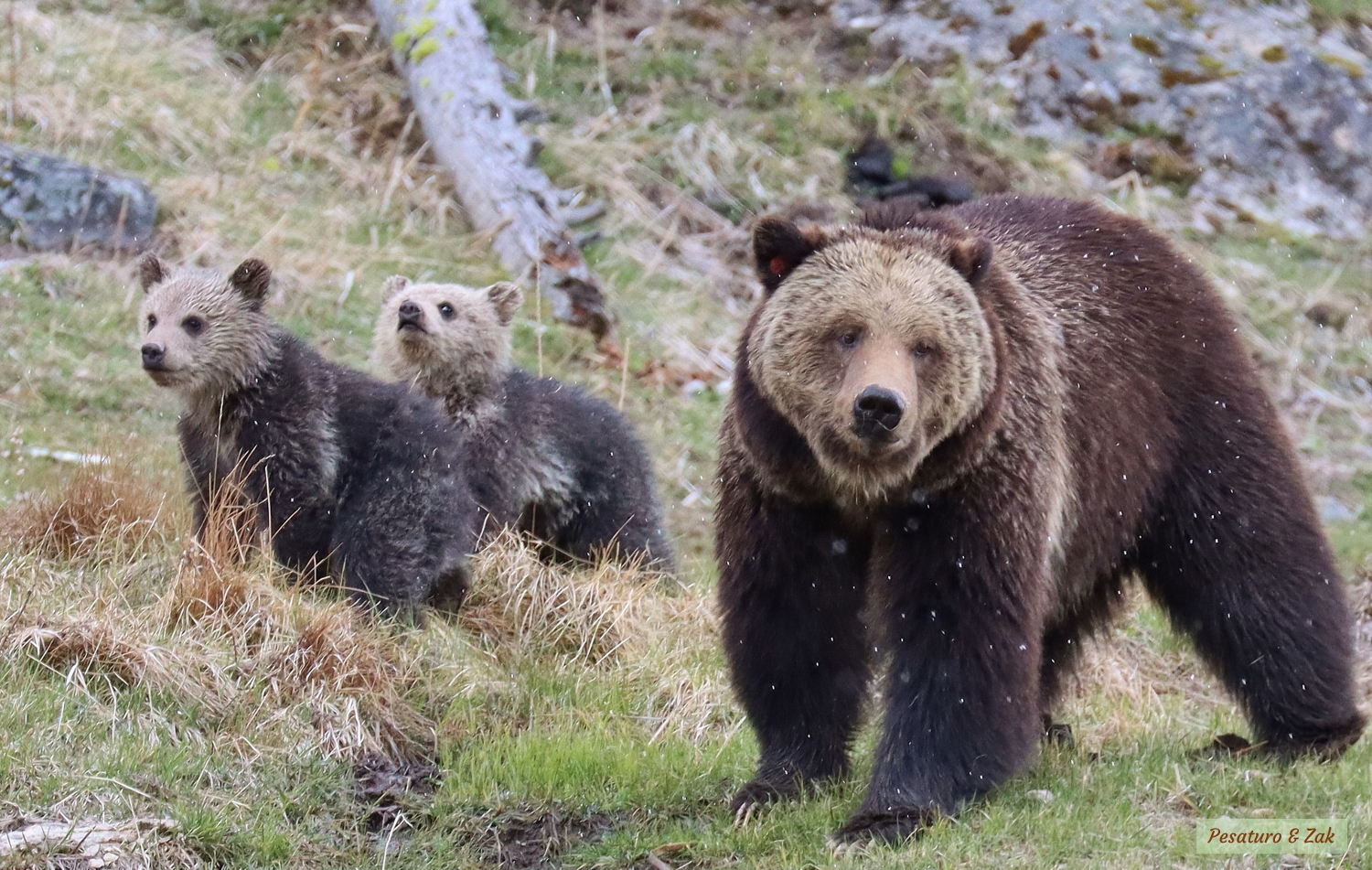

Thr “Bear Rangers” at Yellowstone told me both Grizzly and Black Bear love Biscuit Root. It was a small unobtrusive yellow flower. On a program by some Native Americans, they showed how to find Biscuit Root in the areas between Juniper trees and Sage Brush. They used a special tool, like a round shovel, with a short handle. Push the tool in and twist thru soil to get to root, then pull it out. Often part gets left behind and that leaves a starter for next year.
Oh that’s a great piece of info that little pieces of root left behind can start new plants for next year…because as I looked at these foraged sites, I wondered what impact the bears have on the plant communities. Do they remove so much of their favored plants that they can’t forage in the same place for a few years? Or do the plants regenerate so robustly that they can forage the same sites year after year?
The grizzlies digging up roots is what perpetuates the plant growth! Many native plants populations have dwindled due to being deprived of grizzly interaction and the symbiotic relationship they have.
Here is an awesome podcast episode that goes into depth on the reliance of many species of native plants on human & grizzly interaction; by digging up the roots when they are full of seed (and tastiest), their seeds actually fall into the ground and encourage more plant growth! Super cool. Episode 1 of this podcast: https://www.layinggroundwork.org/our-podcasts/
Thanks! You probably saw the links Pat shared in comments below. Another affect of root grubbing is that the digging leads to an increase in soil nitrogen, which makes the site even better for the glacier lily, which is a favorite food for grizzlies. It’s in the link to Vital Ground in one of Pat’s comments below.
I’ve seen both Grizzlies and Black Bears in Yellowstone feeding in meadows of flowers. Clearly, their noses were working hard to determine which to eat and which to ignore. Dandelions were the favorite, then other forbes. Later in the season, their noses were searching for their favorite roots. I’ve seen mentioned a similar list to what you wrote, but “Pea Soup” is a great way to remember. Also, the root eating behavior appeared to be “secret” in that the bears would stay low to the ground, extract the root, eat, then move to the next. As you said, very hard to identify. There’s a new bear favorite the ranchers discovered: Caraway! They actually prefer it to corn fields.
We also watched black bears foraging in the meadows and the ones we saw were grazing – eating only the above ground portions of plants, not digging for roots. I know they dig sometimes, but not as much as grizzlies, which also dig for pocket gophers and ground squirrels. And coastal populations of brown bears dig up clams. Black bear claws are more curved, so more adapted to to climbing than digging.
Ah yes I have been told about the grizzly’s fondness for wild caraway which is also in the carrot family. They are known to dig it up on a certain ranch just north of Yellowstone, which is probably the ranch you refer to. I wanted to include that in this post, but could not find any documentation of it, and I haven’t observed it myself, so it would be just a “someone told me…”
Some years ago we spent a few days in the backcountry (flew in on a by-plane). Grizzlies all around. We found areas as large and sometimes larger than football fields totally dug up. Amazing how they plow up the ground.
Oh how interesting! Some of the foraged areas we saw did look completely rototilled, while others had a little digging here and there. I wonder how heavy vs light foraging influences the plant community.
Here is the article from the “Missoulian” on Grizzlies, Caraway and Ranchers. Subscription to access in only $6. The date of article is Jan 22, 2022; so it’s current.
https://missoulian.com/news/local/rancher-charts-new-way-forward-for-dealing-with-grizzlies/article_df5125d1-6b05-5e6b-97c1-9efcf59be9c7.html#tncms-source=signup
On the Native America program, they showed roots are hard to dislodge completely, especially with a long thin end for it’s own reproduction survival. Anyone who has grown roots, such as carrots, knows they grow more easily in churned soil. Weather and rain still impact there regrowth rate. An area dug by a grizzly in Denali, was 10′ wide, and churned deeply through out, allowing successful regrowth of the tiny Spring Beauty. The bulb is small, but given to taste delightful by humans alike.
The Black Bears mentioned eating roots in Yellowstone would go after edible roots exposed at the surface. Perhaps the “Bear Ranger” meant what was exposed after a Grizzly had been raking the area. Note this “Bear Ranger” said she passed on tourist questions to the reg Rangers, but are not trained themselves.
Here is the NPS info on what Bears in Yellowstone eat: Invaluable! https://www.nps.gov/articles/yell-wildlife-bear-food-habits.htm?utm_source=article&utm_medium=website&utm_campaign=experience_more
That’s a great article in the Missoulian, describing what those ranchers are doing to coexist. It’s heart warming to know that some are trying and finding cleaver ways.
On the grizzlies eating caraway plants, I was looking for a scientific publication. On blog posts I like to reference something more solid, like a biologist’s article showing a photo of the plant so it can be verified, or a peer reviewed journal article stating that they do in fact eat that plant. That’s what I meant by documentation, and I couldn’t find it for grizzlies eating caraway. Maybe it is in some study and I just haven’t found it…
That NPS chart is nice and easy to read, packs a lot of info into a small space, but I didn’t use to it because there’s a mistake, which made me leery about the rest of the chart. It says biscuitroot is eaten mostly in July and yampah is eaten July through the fall. That’s backwards, according to Dave Mattson’s journal article I cited, “Selection of Microsites by Grizzly Bears to Excavate Biscuitroots” (see “Sources”). He explains that pretty clearly on the first page of that article. (This was actually an important issue in camera placement, because I’d rather target a spot where the bears would likely forage all summer and into the fall, giving me a better chance of capturing the behavior on video, so I needed to know the time of year and for how long they harvest the plants I was finding)
You’re right that taproots like carrots grow more easily in loosened soil but not all plants sprout from pieces of roots. If the plants they eat have gone to seed before they eat it, then new ones would sprout. But if they dig up the plant before it has gone to seed and that species doesn’t sprout from roots, then they’d be reducing its population in that patch.
Another question is how old must the plant be before the roots are big enough for a grizzly to want to harvest it? For example Lomatiums are perennial, not annual, so their roots may be small the first season after sprouting from seed. How many years must pass before they are worth it to bears to harvest them. Also grizzlies do eat some plants before they go to seed. So the point I making is that they probably do have an effect on plant composition, favoring growth of some and deterring growth of others. That probably influences whether they can forage the same patch every year, and probably affects the value of the patch to other species, too.
The only study I could find on their impact on plant communities was on the Alaskan alpine tundra but in that area they mostly dig up burrowing rodents rather than roots, and the plant communities there are different anyway, so I didn’t spend much time with it.
Super interesting topic to me, all of the above, and I’m so glad others are finding it interesting too. Many thanks for taking the time to share your input!
Correction: Here is the source on how Native People find and dig Biscuit Root. https://www.youtube.com/watch?v=GvdrCw63Odc. However it’s a different species from the one at Yellowstone; it’s called “Fern Leaf Biscuit Root.” The flower is much taller. I did notice an interesting point in re-propagation: When digging roots in the Fall, the plant seed heads are dry and easily drop back down to soil in the area and more important, they can drop down in hole left after digging. That makes a quick re-plant in otherwise hard soil, along with root parts not pulled out of the ground.
What a GREAT video! It was great to see what the roots look like, and how they ensure future generations of the plant by harvesting after it has gone to seed, and taking care to plant some seeds!
You should check out the link in my Sources to Mattson’s blog post on “Root Grubbing”, if you haven’t already. In the final 2 paragraphs he describes exactly how grizzlies harvest roots of yampah and sweetvetch. They use a slightly different technique for the each species, because one has bigger roots than the other. Also it’s just plain interesting to see how an animal that doesn’t have tools other than its own body does the job that humans do with tools.
I just read your comment about the article on Grizzlies and Caraway. What a delight to read emphasis on such a rigorous science standard. I do hope you’ll keep us informed on all that you learn! And please include some puzzles for us to think about and investigate. I have a puzzle of my own, identifying the home territory, feeding grounds and route used by a Black Bear to visit our property. He first visited in 2019 with 5″ long paws, in July when male cubs are emancipated to find their own territory. He’s visited at least several times per year since, leaving his growing paw prints and a mark of activity in a variety of ways. He still eludes my Cameras!! Now 4 yrs old, I call him ‘atsili which is “Little Brother” in the area’s Navajo Language.
I hope my cameras get some grizzly action so I have something more to share on this topic! We’re planning to return to that area in late October, so with some luck, a bear will have graced one of our cameras by then. I’m envisioning a beautiful daytime capture up close enough so I can see how he harvests plants…but preparing myself for disappointing B&W night videos…or nothing at all.
On your black bear – It’s so hard to piece together a particular animal’s habitat use at the level of detail you are aiming for, especially if they don’t walk in front of your camera. Have you found marking trees and marking trails in that area? I would think that’d be the easiest way to start. If you can get him on camera using a mark trees and mark trails, you’ll learn part of his route and maybe can begin to identify likely feeding areas and maybe bathing spots.
I’m truly having a blast identifying all the critters that come thru our six acres of Juniper/Pinon, with a high hill and near open areas of fields. I put a camera facing a water dish with trickle water which was a great attraction to learn what critters lived in the area, since this is desert. Then I wanted to know about inter-species scenting habits. I found a half log, partly deteriorated and placed it on their path from water off to the main path elsewhere. Many stopped to read signs, cats to read and scent (Bob Cat, Mt. Lion), Coyotes had to stop every time to pass scent, if not read. We’re in High Desert, and a Javelina female with young won the prize for the most aggressive scenting. Then I found the young Black Bear prints and my focus shifted to him. The bear leaves great sign of marking his temp. beds with scat all the way around. Interestingly, it seems it’s the Coyote who is greatly miffed, completely destroys each and every scat. I have him on camera being very attentive to scent, but that was the night after the scat was destroyed. Also, Mt. Lion scat disappears overnight. //Do you know if Coyotes do this?// I have a map of the bear prints on paths, connecting them with scat-marked beds and water to see how he’s explored and selected delightful beds. All but one, are in a position of some near by cover, like a large bush or tree, and aligned to get favorable breeze and a distant view. Some say the view is for pleasure, but surely it must also be for scent and sounds of possible danger. In winter, the bed was low, out of the wind and nearly surround by a large bush. The bush was normally used by the cats for ambushing hunting. The bear enlarged the bed to be “Bear Size.” Behind that winter bed, was a new “bear size” dust bath. The bear must not be hungry, because we have seeds and nuts in dispensers, and none have been knocked down. This week I found a set of paw print of his size. They headed up the main trail, but right in the middle were three plastic tubes. My husband said “something” had pulled a plastic and rubber line from his office, thru the wall and pulled it 30′ away. The outlet was 4′ off the ground. I know how bears love ants, and therefore Formic Acid in plastic and rubber. I’m sorry I missed that one! With a map connecting the sites used in the past years, I’m going to focus on the “Land Bridge.” In this case, a main trail that facilitates travel in and out of the area just like a log over water. Other cameras will be on both sides of a kids pool, under a tree. The other animals love it and I saw for the first time a pair of Kit Foxes! I added safety rocks and a log in the pool (8″ deep) to give everyone a way out if they accidentally fall in. The pool is also big enough for a hot bear to cool off, if desired. I do hope he knows he’s welcome to get his picture taken.
That’s interesting about the bear and lion scat. Did you get the coyote eating the bear scat or just rolling in it? I don’t know what coyotes do to lion scat. I have heard of dogs eating house cat poop right out of the litter box so….Hmmm 🙂
If I were you I’d set a camera on the next lion scat and see what happens.
Other starter refs to Grizzlies digging and effects on dug area.
Grizzlies eating the bugs in snow: https://www.vitalground.org/winter-wildlife-bugs-snow/
How Grizzly digging effects Meadows https://www.vitalground.org/grizzly-ecology-bears-and-dirt/
Grizzly digging for bugs under rocks (Cut Worms) https://www.vitalground.org/grizzly-ecology-bears-insects/
Here’s an article w a science study ref. on what Grizzlies do to the plants and soil when they dig: https://www.vitalground.org/grizzly-ecology-bears-and-dirt/
Happy (Camera) Hunting!
Thanks! I will peruse that tomorrow.
Coyotes and Bear Poop: What I learned is that “some” animal, obliterates the Bear and Lion scat as I’m thinking “Tomorrow I’ll put up the cam.” Coyotes work the Night Shift and both times beat me to it! Then, I thought to put cams where the Bear Poop I found was on day beds; but it turns out folks are right in saying a bear plops down where it’s most comfortable at the time (sun, shade, breeze, etc.) so I’m always behind the curve. I read that Bear Scat smells sweet and it was early Spring when they might be eating soft twigs. Scat was dry and white-ish indicating protein, but the smell was absolutely sweet like fresh twigs. I hadn’t heard of Coyotes eating scat, but I couldn’t find any that were just “Hockey-Pucked” away, so it’s possible. I set a scent trap (tuna oil) to find who was working the area and got the Coyote being very thorough, but not rolling in it. Just smelling and scenting heavily. Since it was only fish oil, it wasn’t enticing to eat or kick about. Live and Learn. I love Dave Mattson’s hard work published on his Grizzly site. I’ll go read that again.
Thanks for the details. I asked if the coyotes eat it because I know dogs eat poop sometimes. My friend’s dog used to eat cat poop from the litterbox.
Bears do reuse some of their beds so it would be worth it to set a cam on it if you find another bed with fresh scat. I don’t know if scent traps are a good way to find out who was working an area. They can attract animals that had nothing to do with whatever past activity was in the area. I’d focus more on catching the actual activity by targeting a fresh scat with the camera.
Bear Scat Nutritional Value to Coyote
My investigation on Coyotes reason for eating Carnivore Scat on my property, Bear or Mountain Lion: First, the Bear Scat was whitish indicating protein (can’t remember ref. but I’ll find it if interested.) and 2nd, based on direct observation, our Mountain Lions feed on deer, and Bobcats feed on Rabbits and small Rodents with scat containing not fully digested protein.
A Coyote indulging in Bear Scat would add nutrients to his/her self including: (1) Black bear scat is frequently packed with plant material and bug fragments in the spring and early summer. Likewise, scat is produced as loose lumps packed with berries and seeds when the berry season arrives. As omnivores, bears, and Mt. Lions as carnivore, leave the remnants of small mammals like mice and rats along with their scat.–Unattributed on Google, Jul 6, 2022.
And (2) Consumption of Bear scat includes essential elements such as protein, calcium, phosphorus, iron, zinc, potassium, vitamin A, vitamin D, vitamin K, niacin, riboflavin, thiamine, folate, pantothenic acid, biotin, copper, manganese, selenium, iodine, molybdenum, chromium, nickel, cobalt, vanadium, and fluoride. All of these elements add to a healthy system and is even vaguely referred to as an addition to survival food for humans! (Ack!!) By Haley Schroeder Updated on March 16, 2022; “BronnieBakes”
Knowing the Canines are among the family of animals that indulges in eating scat of others, it’s logical, but not proven, that they would eat the scat of Mt Lions and Black Bear for additional health benefit. — Tricky to catch on camera, but I did do the experiment with the fish oil. Next time I find Bear or Lion Scat, I’ll place the camera immediately, before the Coyote has a chance to destroy it unseen.
Sorry, I forgot to reply to this comment. Yes, it’s well known that some animals eat the scat of others. I routinely get blue jays and rodents eating otter scat on camera, and I see rodent sign (tiny holes in cherry pits, e.g.) on seeds in bear scat. And bears are known to eat fresh deer scat, possibly to seed the gut with beneficial bacteria. So it is very possible that the coyotes are eating those disappearing scats. Would love to know if you get it on camera.
Oh I almost forgot to mention – we recently targeted a bear scat full of fruit/seed/nut remains with a trail cam and got gray and red squirrels at it, probably eating. A coyote passed by ignoring the scat….but that’s just an n of 1.
Very interesting conversation Janet and Patricia! And great post in general. Thank you!
I’m glad you found it interesting. Thanks for reading, and for commenting!
Pingback:Black Bears Eating Insects: Foraging Sign & Behavior - Winterberry Wildlife
Pingback:Grizzly vs Black Bear Tracks: A Careful Look - Winterberry Wildlife